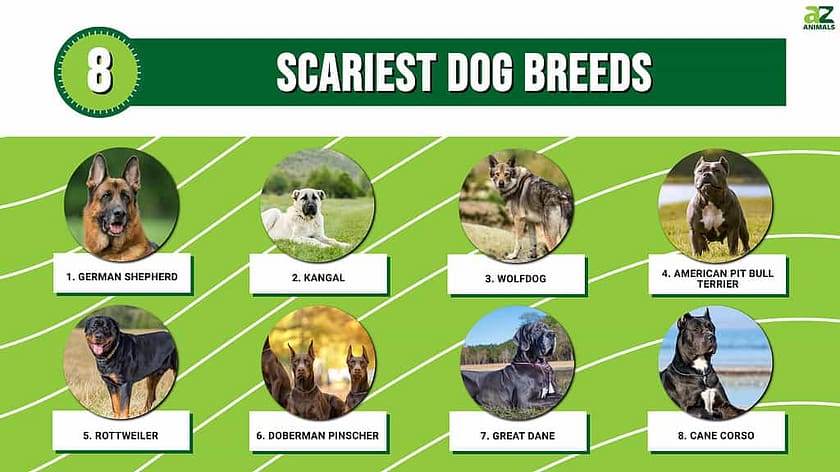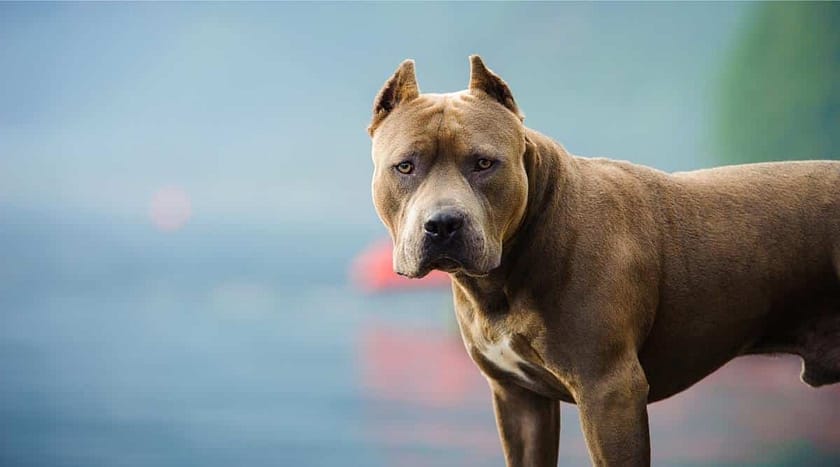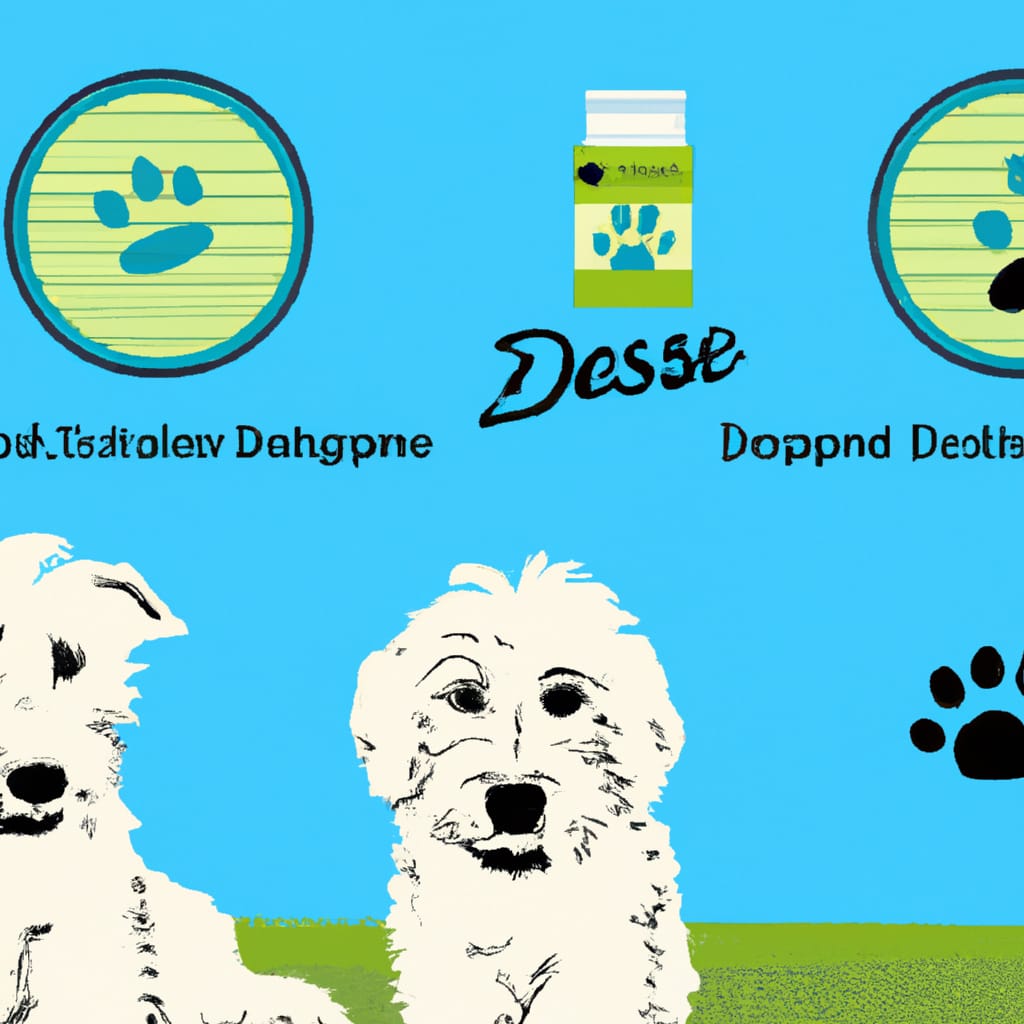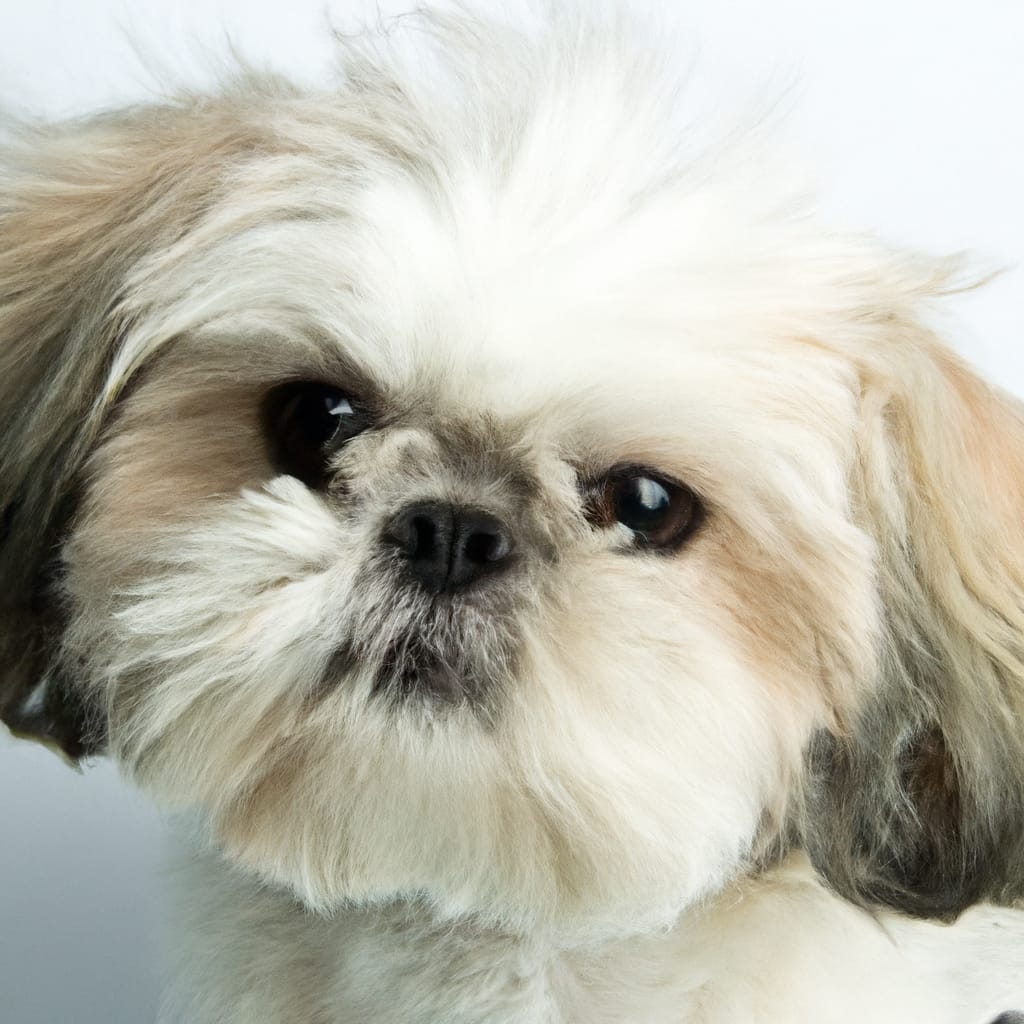Top 10 Scariest Dog Breeds In The World
Imagine walking down a dark street, heart pounding, when suddenly you come face to face with a menacing creature. No, it’s not a horror movie monster or a supernatural being – it’s a dog. Yes, even our furry friends can give us the shivers sometimes, especially if they belong to one of the top 10 scariest dog breeds in the world. From their imposing size to their intense gaze, these dogs are guaranteed to send chills down your spine. In this article, we’ll take a closer look at these breeds and uncover what makes them so fear-inducing. Get ready to discover a whole new side to man’s best friend.

1. Rottweiler
– History of the Rottweiler breed
The Rottweiler, with its strong and powerful appearance, has a long history dating back to ancient Rome. These dogs were originally used as herding dogs, helping to drive and guard livestock. They were also utilized for their strength in pulling carts and protecting their owner’s belongings. Over time, the breed evolved and became known as Rottweilers, named after the town of Rottweil in Germany where they were commonly found.
– General characteristics of Rottweilers
Rottweilers are known for their muscular build, broad chest, and distinctive black and tan coat. They are a large breed, usually weighing between 80 to 135 pounds and standing 22 to 27 inches tall at the shoulder. Rottweilers are known to have a confident and self-assured demeanor, but they are also highly intelligent and trainable. They are incredibly loyal to their families and can be fiercely protective.
– Aggressive behavior tendencies
While Rottweilers are often labeled as aggressive, it is important to note that aggression is not inherent to the breed. Like any dog, a Rottweiler’s behavior is largely determined by their upbringing, socialization, and training. However, due to their protective nature and physical strength, it is crucial for owners to provide proper training and socialization to ensure that their Rottweiler is well-mannered and well-behaved.
– Training and socialization
Training and socialization are essential for Rottweilers to become well-adjusted and balanced dogs. Positive reinforcement methods such as reward-based training should be employed to encourage good behavior and discourage any aggressive tendencies. Early and ongoing socialization is also important to expose Rottweilers to various people, animals, and situations to help them become comfortable and confident in different environments.
– Responsible ownership and management
Being a responsible owner of a Rottweiler means providing proper care, training, and socialization. Adequate exercise and mental stimulation are crucial to prevent boredom and potential destructive behavior. Maintaining a calm and consistent environment will also help in managing the breed’s natural protective instincts. Responsible ownership also includes spaying or neutering, regular veterinary check-ups, and adhering to local laws and regulations.
2. Pit Bull
– Origins and history of Pit Bulls
Pit Bulls, often misunderstood, have a rich history that traces back to England in the 19th century. These dogs were originally bred for bull-baiting and later became popular in the gruesome sport of dogfighting. However, despite their unfortunate past, Pit Bulls were also cherished as family pets due to their loyalty, affectionate nature, and natural ability to work with people.
– Physical appearances of Pit Bulls
Pit Bulls are medium-sized dogs with a muscular and athletic physique. They have a short and smooth coat that comes in various colors, including brindle, black, brown, and white. Pit Bulls have a broad head, defined jawlines, and powerful neck muscles. Despite their strong appearance, their expressions are often described as friendly and loving.
– Misconceptions and breed stereotypes
Pit Bulls have become victims of negative stereotypes fueled by media and public perception. They are often wrongly associated with aggression and violence. However, it is essential to understand that a dog’s behavior is shaped by many factors, including upbringing, training, and socialization. Responsible owners of Pit Bulls understand the importance of providing love, proper care, and training to dispel these misconceptions.
– Training and socialization importance
Training and socialization play a crucial role in the well-being and behavior of Pit Bulls. Early socialization helps them become comfortable and friendly towards different people, animals, and environments. Positive reinforcement-based training methods are highly recommended to encourage good behavior and build a strong bond between the owner and the dog. Pit Bulls are intelligent dogs and thrive when provided with mental stimulation and regular exercise.
– Responsible Pit Bull ownership
Responsible ownership of a Pit Bull involves providing them with the necessary care, exercise, and love they deserve. Regular veterinary check-ups, proper nutrition, and grooming are important aspects of responsible pet ownership. Furthermore, it is crucial to adhere to local laws and regulations, including spaying or neutering your Pit Bull and ensuring they have proper identification tags and licenses.
3. Doberman Pinscher
– Doberman breed background
The Doberman Pinscher, known for its sleek and elegant appearance, was developed in Germany in the late 19th century. Their creation was attributed to a tax collector named Louis Dobermann, who aimed to breed a loyal and protective dog to accompany him during his work. Over time, the breed was refined and became popular worldwide for their intelligence, loyalty, and versatility.
– Physical traits and characteristics
Doberman Pinschers are medium to large-sized dogs with a well-muscled and compact build. They have a short coat that can come in various colors, including black, red, blue, and fawn. Their slim and athletic bodies give them a graceful and agile appearance. Dobermans have an alert expression with ears that are often cropped to stand erect.
– Fear-inducing appearance
Doberman Pinschers often have a reputation for looking intimidating due to their sleek and powerful appearance. Their cropped ears and docked tails can also contribute to this image. However, it is essential to note that a dog’s appearance does not necessarily reflect their temperament or behavior. With proper training and socialization, Dobermans can be friendly, loyal, and well-mannered companions.
– Loyal and protective nature
Dobermans are known for their loyalty and natural protective instincts. They have an innate desire to please their owners and are highly trainable. With proper socialization, they can be friendly towards strangers and other animals while remaining vigilant in protecting their family and territory. Their loyalty and protective nature make them excellent companions and potential working dogs in various fields.
– Training and socialization requirements
Training and socialization are crucial for Doberman Pinschers to ensure they develop into well-rounded dogs. Early socialization should involve exposure to different people, animals, and environments, which helps prevent fear-based aggression. Positive reinforcement-based training methods work well with Dobermans, as they respond positively to praise and rewards. Mental stimulation and regular exercise are also vital to keep their active minds and bodies engaged.
4. German Shepherd
– Origins and popularity of German Shepherds
German Shepherds, often recognized for their intelligence, versatility, and loyal nature, originated in Germany in the late 19th century. They were initially bred as working dogs, excelling in herding and guarding livestock. German Shepherds gained worldwide recognition due to their exceptional trainability, making them highly sought-after in various roles, including search and rescue, police work, and assistance for individuals with disabilities.
– Intelligence and versatility
German Shepherds are widely regarded as one of the most intelligent dog breeds. They are quick learners and possess a strong work ethic, making them suitable for a variety of tasks. German Shepherds excel in obedience training, agility competitions, and advanced problem-solving exercises. Their versatile nature enables them to adapt to different environments and fulfill various roles effectively.
– Guarding instincts and territoriality
German Shepherds have a natural instinct to protect their family and territory. This trait, coupled with their intelligence, makes them excellent guard dogs. However, it is vital for owners to provide proper training and socialization to prevent territorial aggression. Early exposure to different people and situations helps German Shepherds understand what is normal and reduces the chance of them becoming overly protective.
– Training and exercise needs
German Shepherds require mental and physical stimulation to maintain their well-being. Regular exercise, such as daily walks, playtime, and interactive games, helps prevent boredom and destructive behavior. Engaging their minds through obedience training, puzzle toys, and interactive training sessions is equally important. German Shepherds thrive in environments where their intelligence is challenged and their energy is well-utilized.
– Temperament and aggression issues
German Shepherds, when properly trained and socialized, have a balanced and stable temperament. However, like any dog breed, there is a potential for aggression if not given the necessary attention and care. Responsible ownership involves providing consistent training, setting clear boundaries, and ensuring appropriate socialization from a young age. It is important to address any aggression issues promptly and seek professional help if needed.

5. Belgian Malinois
– History and breed development
Belgian Malinois, a breed known for their high drive and extraordinary work capabilities, originated in Belgium. They were developed in the late 19th century as herding dogs, assisting farmers in managing their livestock. Over time, their intelligence, agility, and versatility led them to excel in various fields, including military and police work, search and rescue, and competitive dog sports.
– High drive and work capabilities
Belgian Malinois are highly energetic and possess an intense drive to work. They require mental and physical stimulation to maintain their well-being. This breed thrives in environments where they have a job to do and an outlet for their energy. Belgian Malinois’ exceptional work capabilities make them ideal for tasks that demand focus, agility, and determination.
– Protective nature and guarding instincts
Belgian Malinois exhibit a natural protective nature towards their families and territory. This protective instinct, combined with their high intelligence, makes them excellent guard dogs. However, it is crucial for owners to provide proper training and socialization to ensure that their protective instincts are channeled appropriately and do not manifest as aggression towards unfamiliar people or animals.
– Training and mental stimulation requirements
Belgian Malinois require mental stimulation just as much as physical exercise. Obedience training, advanced problem-solving exercises, and engaging activities like agility or scent training are vital to satisfy their intelligent and active minds. Early socialization is important to ensure they develop good manners and are comfortable in various situations, especially when encountering unfamiliar people or animals.
– Potential aggression challenges
While Belgian Malinois are not inherently aggressive, their high drive and protective instincts can potentially lead to aggression if not managed properly. Responsible ownership involves providing consistent training, regular exercise, and mental stimulation to prevent boredom and unwanted behavior. Socialization should be ongoing to cultivate positive experiences and reduce the likelihood of aggressive reactions.
6. Chow Chow
– Origin and history of Chow Chows
The Chow Chow, with its unique appearance and independent nature, originated in China several thousand years ago. Initially, they served as working dogs, utilized for various tasks such as hunting, herding, and guarding. Chow Chows have a rich cultural significance in China and were often symbols of nobility and prestige. They later gained recognition in Western countries and gained popularity as family pets.
– Distinctive physical features
Chow Chows are known for their distinctive physical features, including their thick double coat, lion-like mane, and blue-black tongue. They have a strong and muscular build, giving them an imposing appearance despite their medium-sized stature. Their broad skull and deep-set eyes contribute to their unique facial expression.
– Independent and aloof temperament
Chow Chows are known for their independent nature and reserved personality. They exhibit a strong sense of self and are often aloof towards strangers. While they can form strong bonds with their families, Chow Chows are not known for being overly affectionate or eager to please. This breed requires firm and consistent training to establish boundaries and ensure proper behavior.
– Training and socialization for better behavior
Early training and consistent socialization efforts are crucial for Chow Chows to develop good behavior. Positive reinforcement methods work best with this breed, as they respond well to rewards and praise. Socialization should involve exposing them to various people, animals, and environments to help them become more accepting and comfortable in different situations.
– Potential aggression triggers
Chow Chows, like any breed, can exhibit aggression if not properly trained and socialized. Their independent nature and reserved personality can sometimes lead to protective or defensive behavior. Responsible ownership involves providing clear boundaries, ongoing training, and ensuring that potential aggression triggers are minimized. Consulting with a professional trainer or behaviorist can be beneficial in managing any aggression issues should they arise.

7. Akita
– Japanese origins and history
The Akita, originating from Japan, has a long and storied history. They were initially developed as hunting dogs, used to track and hunt large game such as boar, deer, and bears. Over time, they gained recognition as loyal and protective companions and became symbols of good health, happiness, and longevity in Japanese culture.
– Powerful and dominant breed characteristics
Akitas are known for their powerful and dominant demeanor. They are a large breed, often weighing between 75 to 130 pounds and measuring 24 to 28 inches at the shoulder. Their strong build, thick double coat, and curled tail give them a regal and imposing appearance. Akitas possess a natural confidence and can be independent thinkers, which may require a firm and consistent approach to training.
– Protective nature and loyalty
Akitas have a strong instinct to protect their families and can be fiercely loyal. They form deep bonds with their owners and are known for their unwavering loyalty. Akitas are renowned for their bravery and have been known to put themselves in harm’s way to protect their loved ones. Their protective nature can make them excellent guard dogs when appropriately trained and socialized.
– Training and socialization for a well-balanced Akita
Early training and socialization are essential for Akitas to develop into well-behaved and balanced dogs. Positive reinforcement training methods work well with this breed, as they respond to rewards and praise. Socialization should begin from a young age and expose Akitas to various people, animals, and situations to ensure they are comfortable and confident in different environments.
– Aggression issues and management
Like any large and powerful breed, Akitas have the potential for aggression if not properly trained and socialized. Dominance-based aggression and resource guarding are possible challenges with this breed. Responsible ownership involves understanding the breed’s needs, providing consistent training and socialization, and ensuring a secure and safe environment. Addressing any aggression issues promptly and seeking professional guidance can help manage potential challenges effectively.
8. Cane Corso
– Italian history and background
The Cane Corso, a breed originating from Italy, has a rich history dating back to ancient Roman times. They were initially bred for various tasks, such as guarding property, hunting, and working with livestock. Cane Corsos were valued for their strength, agility, and loyalty, which made them highly sought-after companions and working dogs throughout history.
– Muscular physique and intimidating appearance
Cane Corsos possess a large and muscular physique, giving them a commanding presence. They have a broad head with a square-shaped muzzle and powerful jaws. Their short coat comes in various colors, including black, fawn, gray, and brindle. Cane Corsos’ intimidating appearance, coupled with their natural guarding instincts, makes them an excellent choice for those seeking a protective companion.
– Guardian instincts and territoriality
Cane Corsos have an inherent instinct to protect their families and territory. Their loyalty and dedication make them natural guardians. It is important for owners to provide proper training and socialization to prevent territorial aggression. Early socialization that exposes Cane Corsos to various people, animals, and situations is crucial to instill good manners and ensure they are comfortable in different environments.
– Training and socialization to prevent aggression
Training and socialization are key to ensuring that Cane Corsos develop into well-behaved and balanced dogs. Positive reinforcement training methods work best with this breed, as they respond positively to rewards and praise. Ongoing socialization efforts should be implemented to expose Cane Corsos to different people, animals, and situations from a young age, which helps prevent fear-based aggression.
– Responsible ownership and supervision
Responsible ownership of a Cane Corso involves providing proper care, training, and supervision. Regular exercise and mental stimulation are crucial for their well-being. A secure and safe environment is necessary to prevent any potential aggression triggers. Responsible ownership also includes regular veterinary check-ups, maintaining a balanced diet, and adhering to local laws and regulations.

9. Presa Canario
– Canary Islands origins
The Presa Canario, originating from the Canary Islands, has a long history as a working breed. They were primarily bred for guarding livestock, hunting wild animals, and protecting property. Presa Canarios possess a strong and muscular build, reflecting their past as working dogs. Over time, they have gained recognition for their loyalty and protective instincts.
– Large and powerful breed traits
Presa Canarios are a large and powerful breed, often weighing between 90 to 130 pounds and standing between 22 to 26 inches tall at the shoulder. They have a broad head with a strong jaw and a thick neck. Their short coat can come in various colors, including brindle, fawn, and black. The Presa Canario’s physical traits contribute to their intimidating appearance.
– Natural guarding and prey drive instincts
Presa Canarios have a natural instinct to guard and protect their families. Their loyalty and protective nature make them excellent guard dogs when properly trained and socialized. Additionally, they possess a prey drive instinct, which can make them inclined to chase small animals. Owners must provide consistent training and socialization to control and manage these natural instincts.
– Training and socialization to ensure proper behavior
Training and socialization are crucial for Presa Canarios to ensure they develop into well-mannered dogs. Early socialization should include exposure to various people, animals, and situations to teach them appropriate behavior. Positive reinforcement training methods, such as rewards and praise, work best with this breed. They respond well to structured training that establishes clear expectations.
– Aggression potential and measures of control
While Presa Canarios have the potential for aggression due to their protective instincts and size, responsible ownership can help manage and prevent aggression issues. Owners should prioritize training and provide consistent and positive reinforcement to establish control and boundaries. Seeking professional help and guidance can be beneficial in addressing any aggression concerns that may arise.
10. Bullmastiff
– Breed history and purpose
Bullmastiffs, a breed originating in England, were developed in the 19th century to protect gamekeepers and their estates from poachers. They were bred by crossing English Mastiffs with Bulldogs, resulting in a breed that possessed both size and strength, as well as the ability to track and apprehend intruders.
– Robust size and strength
Bullmastiffs are a large and powerful breed, often weighing between 100 to 130 pounds and standing 24 to 27 inches tall at the shoulder. They have a solid and muscular build, contributing to their imposing appearance. Their short coat comes in various colors, including fawn, brindle, and red. Despite their size, Bullmastiffs are known for their gentle and loving nature.
– Alertness and protective nature
Bullmastiffs have an innate sense of alertness and a natural protective nature. They are known for their loyalty and dedication to their families, making them excellent guard dogs. Their imposing appearance, deep bark, and robust size act as deterrents for potential intruders. Bullmastiffs have a calm and gentle temperament but are quick to act when they sense a threat.
– Training and socialization requirements
Training and socialization are important for Bullmastiffs to develop into well-behaved and balanced dogs. Early socialization helps them become familiar and comfortable with various people, animals, and environments. Bullmastiffs respond well to positive reinforcement training methods, which involve rewards and praise. Consistency, patience, and gentle guidance are key to their successful training.
– Aggression tendencies and responsible ownership
While Bullmastiffs are generally gentle and laid-back, they have the potential for aggression if not properly trained and socialized. Responsible ownership involves providing consistent training, setting boundaries, and ensuring proper socialization from a young age. Early identification of any aggression tendencies is important, as seeking professional guidance can help prevent or manage aggressive behavior effectively.













